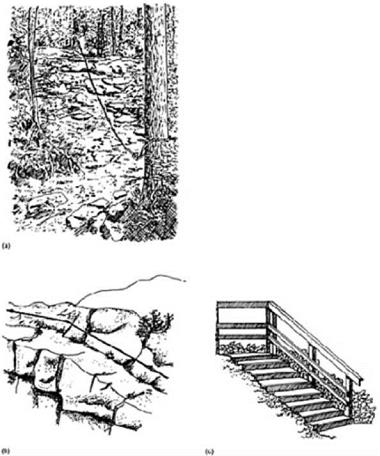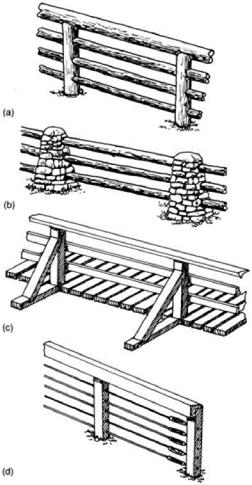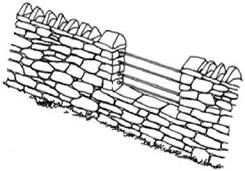In most circumstances where water has to be crossed special structures should be provided, such as culverts as previously described, some kind of ford, stepping-stones or other informal means, or bridges. In wilder, more rugged terrain, where primitive experiences and a greater expectation of selfreliance on the part of visitors are expected, crossing streams can be an exciting and challenging experience. Unbridged crossings should be the normal practice, but safe crossing points must be selected, and warnings should be posted about the potential dangers of crossing rivers during floods, together with advice on alternative routes. However, where the water level can fluctuate quickly and torrent conditions are likely to persist for some time, crossing structures should be provided.
Fords
The walker must be able to wade through the water at a place where strong and turbulent currents are unlikely or absent, and where the water is usually fairly shallow. A section of stream where the water flows more slowly and the stream bottom is fairly even and firm should be chosen, and the path should be directed to and from it. If there is some risk from strong
 |
Climbing aids: (a) This knotted rope strung
between two trees makes a useful aid for climbing up a steep rocky stretch on an otherwise easy woodland trail. Mount Orford Provincial Park,
Quebec, Canada. (b) A steel cable fastened to eyelets fixed in the rock gives help and security for walkers along a cliff or ledge path in mountainous terrain. Based on examples from the Austrian Alps. (c) A sturdy timber handrail helps people to climb steeper steps, and is especially useful when the path follows a steep slope with a substantial drop to one
|
side.
|
Some varieties of handrail for safety or support: (a) Round timber used to give a strong rail. The bigger size of timber looks appropriate outdoors. (b) This design of heavy round rails set in uprights made of rock is based on 1930s CCC designs. It is strong, and can be constructed where posts cannot be dug into the ground because of rock. (c) Handrails on boardwalks or decking need to be given strength, to resist horizontal pressure, using outriggers
and struts. (d) Tensioned cables used instead of rails can give less impact, and permit views through them by children or people in wheelchairs.
|
|
A handrail of an easier size to grip set beneath a heavier, stronger toprail combines visual appearance and function.
|
|
A wall used as a safety barrier provided with
pointed capstones to deter climbing or sitting on the top. A panel infilled with tensioned cables allows views through the wall by children or people in wheelchairs.
currents, and the ford is wide, large stones should be placed on the immediate downstream side of the crossing place to act as safety barriers. These give walkers something to hold on to if required, and can prevent anyone from being washed away. Although not designed as stepping-stones, they may be used

as such if they stand out of the water, and are spaced reasonably close with flattish surfaces.
In less wild areas, and for an easier crossing, the ford can be given a better bottom surfacing using large, flat, rough – textured stones interlocked together. On popular routes, this may be advisable to prevent degradation of the crossing surface.






